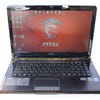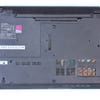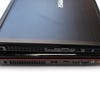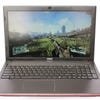MSI GE40/GE60 gaming laptops review
Haswell meets second-gen Kepler in two ambitiously specced gaming laptops.
Though better known as a vendor for graphics cards, MSI has some noteworthy experience in the realm of notebook design too, showing no hesitation in stepping on Alienware's turf at the higher-end of the gaming laptop market. With the roll-out of Intel's fourth generation of Core CPUs, it has decided that now's the time to unveil its very first 14-inch GE40 laptop, and also bring the revised Haswell architecture to its 15.6-inch GE60. As both come equipped with Nvidia dedicated GPUs as well, we're looking at an unprecedented spec-list here, and one which poses serious questions regarding heat and power intake. MSI promises to offset this by using its new Cooler Boost 2.0 technology, and by suiting each with sizeable batteries - but is this really enough?
Let's take a brief look at the specs first; on the CPU side, each laptop is equipped with processors fabricated at the 22nm process, with Intel declaring its latest mobile chips improve power efficiency over the previous Ivy Bridge design by means of superior idle power management. The smaller GE40 model comes installed with an Intel Core i7-4702MQ, rated with a thermal-design power value of 37W that compares favourably against the 47W of the GE60's processor, the marginally faster i7-4700MQ. Given the larger battery capacity of the smaller laptop as well, all signs point to a much more flexible battery life for the GE40.
On the GPU side, power ratings lurk at around 50W for the dedicated Nvidia GTX 760M found in the GE40. This is a hard-fought rating, particularly given that this is based on the same GK106 chip as the 765M version used for the larger laptop, where the power draw theoretically peaks at up to 75W.
The only difference between the two is a core downclock from 800MHz to 650MHz, while everything from the 768 CUDA cores, 128-bit memory bus and their 4GBps memory speeds remain identical. Naturally, the CPU's integrated HD 4600 graphics takes charge outside of 3D applications such as games, switching over according to cue in the interest of saving power.
The physical design of the laptops has a huge bearing not on just on heat dissipation, but general usability for mobile gaming. Declared by MSI to be the thinnest and most lightweight gaming notebook, the GE40 crams these components into a chassis measuring under 30mm in thickness while closed, and weighing in at just 1.95kg in this configuration. There's some flex to its aluminium-brushed lid, and the use of glossy plastics on the inside cheapens the feel of the unit, whilst also making it very prone to finger-print smudges during use. Even so, the choice of build materials no doubt helps to meet its target in weight.
The GE60 adds some flair to its design by splashing red sports lines across its lid and rim, while a glossy piano lacquer finish is used for the shell. Again, it's a nightmare to keep on top of fingerprints while opening and closing the unit, to the point where it becomes more hassle than it's worth to keep a cloth handy. On parsing open the laptop we touch on a distinctly rough edge to the top of the lid, as if the matte bezel and glossy plastic for the exterior are misaligned at the meeting point by a millimetre. Even so, the cool metallic finish of the insides is a big upgrade over the GE40s predominate reliance on plastics, and it still feels relatively lightweight given its contents include two SSDs, a single 1TB HDD, and an optical drive. In either laptop's case, the positioning of ports is similar, with the DVD-RW bay situated to the right side, and main heat vents planted to their back-left.
When put to use for browsing, the keys on the GE40's chiclet-style keyboard produce a noisy tap to the touch, and don't sink with any of the firmness of the GE60's SteelSeries full-size keyboard. The low-travel keys of this larger laptop are far easier to work with in word processing, and provide a much more tactile feel that also allows for more responsive simultaneous presses. Otherwise, the GE40's trackpad is a solid effort which registers Windows 8's multi-touch gestures smoothly, below which a single chrome strip is used for left and right clicks. For some, this design may be preferable to the GE60's mouse buttons, which integrate into the foot of the trackpad itself, taking some getting used to.
We're pleased to see anti-glare matte coating used across the board for MSI's laptop displays, which helps to no end in avoiding obtrusive glare while outdoors. Certainly, there are poor vertical viewing angles owing to the TN panels being employed, but the contrast on the GE60's screen is among the more impressive we've seen from the technology, with colours standing out regardless of the scene.
By comparison, the GE40's smaller 14-inch display looks a touch washed out when brightness is cranked up to 100 percent during darker scenes in films. At 1600x900 it's also missing the crisper dot pitch of the full 1080p seen in the larger laptop, the trade-off being that it has a lower fill-rate demand to meet in order to play games at its native resolution.
Sound arrives to both laptops via a single grilled bar just above these keyboards, with the GE60 also offering two additional speakers at the front of its chassis. Although the presence of bassier sounds is expectedly limited for laptops, the volume is raised to maximum without any hint of distorted or peaky trebles ruining the more explosive moments in Battlefield 3. However, the reality of cramming so many components into the GE40's diminutive dimensions is that it relies upon smaller fans to cool the system compared to a regular desktop - equating to a louder overall sound signature when ramped up to their maximum velocity. For practical use during demanding games on this smaller laptop, this means the fans and speakers regularly duke it out for aural supremacy - with speakers typically providing just enough oomph to win out.
Another major point in favour of the larger GE60 is data access speed, being configurable with up to two 128GB SSDs in RAID-0, thereby offering up a theoretical read and write rate of 1GB/s. This bursts past the ballpark 100MB/s speeds we see on its accompanying 1TB HDD, and reduces Windows 8 boot times to just eight seconds. While our ATTO benchmark test records only a peak of 750MB/s when reading data, and 290MB/s while writing, this is still hugely effective for chopping down mission loading times in Crysis 3 to a matter of seconds. It's a pretty frivolous extra, and can laughably be upped once again to three SSDs for higher-end laptops such as MSI's 17.3-inch GT70, which raises the theoretical ceiling once more to 1.5GB/s.
However, with all these parts packed into such a tight space, MSI may have bitten off more than it can chew when it comes to managing heat levels. There's no bones about it: the GE40 and GE60 run very hot when the going gets tough. Specifically, it's the smaller notebook that produces the more alarming heat statistics after running the Metro: Last Light benchmark at high settings for just fifteen minutes. Even with the unit left on a wooden table at a room temperature of 21 degrees Celsius, the CPU rises to a peak figure of 95 degrees, as compared to the still toasty 93 on the GE60. It's a worrying value to behold, and while most games only effectively keep the laptops fired up to the 80 mark, it can make for an uncomfortable sensation on the wrists during play.
Strangely, we see both the GE40 and GE60 cranking clocks up to the maximum 3.2GHz and 3.4GHz respectively, despite having little thermal headroom to truly afford it. Throttling these clock speeds downward might have made more sense, but even Intel's own Extreme Tuning Utility shows no such downclocks to the CPU are ever in effect. Rather, running a stress test for three hours has the throttling percentage indicator hold steady at zero per cent for the GE60, regardless of the temperature averaging at 90 degrees Celsius.
"Strangely, we see both the GE40 and GE60 cranking clocks up to the maximum 3.2GHz and 3.4GHz respectively, despite having little thermal headroom to truly afford it."

Going hand-in-hand with this heat dilemma is the point of the battery life. From the onset there is a clear favourite, with the GE40 boasting a larger capacity 5700mAh battery than the GE60 with its 4400mAh solution. Tallied up with the notebook's inherently lower CPU and GPU clock speeds, its 1600x900 native resolution, dimmer screen and smaller speakers, we're left hoping it'll have a far better stab delivering gaming on the go.
The good news is that conservative use of the GE40, keeping WiFi enabled with brightness and volume at 50 per cent, gives us six hours and 30 minutes total running time for light applications, such as web browsing. We also put video playback on BBC's iPlayer to the stopwatch under the same conditions, recording an impressive three hours, 15 minutes before the unit conks out. Sadly, we can only keep a game of Battlefield 3 running off-the-mains for one hour and 35 minutes, after which a two hour recharge is necessary. With more frugal management of GPU clocks and screen brightness it's possible to squeeze a few more minutes out of the machine, but even so the results are roughly on par with those seen from Alienware's Ivy Bridge-based M14x notebook last year.
The GE60 expectedly fares much worse here for all its excesses, despite booting games from a more power-efficient SSD arrangement. For general web browsing use under matching settings it lasts little over three hours, while letting iPlayer stream the latest season of Horrible Histories gives us just one hour and 50 minutes of constant playback before cut-out. Gaming gets all pistons pumping, meanwhile, with the total time on the road amounting to only 55 minutes during a test of Battlefield 3 multiplayer. Thankfully, recharge times come in at just under two hours, but these results barely speak to the advantages in fourth generation mobile Intel CPUs, as compared to the previous generations. The truth is, Haswell excels at idle and middling work rates, but with the processor operating at maximum warp, there's little to differentiate it from last year's Ivy Bridge.
Gameplay analysis: performance tests
With heat at an alarming high and battery lifespans at a sobering low, the trade-off must surely be exceptional metrics while gaming. For our practical tests, we lock and load the GE40 and GE60 laptops with Nvidia's latest drivers, which better optimises their respective 760M and 765M graphics chips for new entries in the modern gaming canon, such as Metro: Last Light. As each laptop sports different standards of native resolution - one being 1600x900 and the other being 1920x1080 - we opt to compare performance at both in the interest of a fair test.
"768 CUDA cores on each GPU makes Metro's high graphics preset easy to hit, preserving screen-space ambient occlusion (SSAO), higher resolution shadows, and camera object blur in one fell swoop."
Alternative analysis:
To start off, we run a scripted sequence from the Welcome to the Jungle stage in Crysis 3, leading into a rainy battle sequence around a guarded industrial area. Of all three DirectX 11 games - incidentally all shooters of a high visual pedigree - this is the one where we have to bail on our attempts to run at high settings, and instead select the medium preset in order to achieve a ballpark 30fps at 1080p. The drop to 1600x900 - '900p' if you will - makes this a more comfortable target, given the restrictive 128-bit gate leading to both GPUs' 2GB GDDR5 RAM. This gives us a boost up to 40fps, but throughout both analyses the GE40 and GE60 are barely distinguishable in performance.
However, Metro: Last Light makes a more convincing argument for going with the GTX 765M as a mobile GPU, rather than the downclocked GTX 760M of the smaller laptop. As we walk through the Separation mission, this makes the difference between staying just ahead of the 30fps line, and dipping below it regularly during battle. Alas tessellation is too much of a performance hog here, bringing frame-rates for the NPC-populated area seen in the Reich mission down to its knees.
Despite this concession, the healthy count of 768 CUDA cores on each GPU makes Metro's high graphics preset easy to hit, preserving screen-space ambient occlusion (SSAO), higher resolution shadows, and camera object blur in one fell swoop. At 6fps lower on average during the 1080p test, the GE40 certainly struggles with 4A Games' latest, but the smoother performance at 900p shows how well the laptop screen's native resolution sits with its graphical capabilities.
"Metro: Last Light makes a more convincing argument for the GTX 765M rather than the downclocked GTX 760M of the smaller laptop, keeping frame-rates north of the 30fps standard."
Alternative analyses:
Even with the fourth entry due this upcoming November, Battlefield 3 remains a technical showcase for DICE's multi-core Frostbite engine. It's the oldest of the trio being tested, but feels the best optimised for both mobile systems - pushing the GE40 to almost 60fps at times on high settings. During battle we see a strong adherence to the 45fps line while running at 900p on the plucky notebook, and though the GE60 runs at a marginally higher rate, the end results during the Operation Swordbreaker mission's parking lot battle proving to be perceptibly similar.
As an example of where performance goes when tessellation is enabled, we run Metro: Last Light's benchmarking tool with all other visual settings set to normal. Gruelling as it may be for the GE40, the GE60 actually acquits itself very nicely with this setup and consistently holds at above the 30fps average mark. Where other game benchmarks are concerned, results are even more encouraging.
At a likewise medium-grade preset with tessellation and FXAA engaged, each game still matches or exceeds the coveted 60fps mark. However, there are some stragglers in the collection, like Bioshock Infinite, which press the 64GB/s memory fill-rates of each laptop while running at 1080p. Hitman: Absolution also strains both units once tessellation is thrown into the blender, thanks to it packing ostensibly hundreds of NPCs into the frame to take advantage of the extra geometric processing. Of course, the effective frame-rate during the game's campaign is much more forgiving, this being the very worst case scenario.
"The GE40 is ultimately better balanced as a mobile gaming machine. The 1600x900 resolution screen and curtailed 650MHz core clocks of its GTX 760M GPU tie in nicely with a more capacious battery for extended mobile gameplay."
| GE40 1600x900 | GE60 1600x900 | GE40 1920x1080 | GE60 1920x1080 | |
|---|---|---|---|---|
| BioShock Infinite, Medium | 60.1FPS | 53.8FPS | 49.4FPS | 54.5FPS |
| Tomb Raider, Medium, Tessellation, FXAA | 68.6FPS | 76.1FPS | 52.7FPS | 60.1FPS |
| Metro: Last Light, DX11, Medium, FXAA | 33.5FPS | 36.4FPS | 26.2FPS | 28.7FPS |
| Hitman: Absolution, Medium, FXAA | 46.9FPS | 47.7FPS | 39.6FPS | 43.3FPS |
| Sleeping Dogs, Medium, FXAA | 63.6FPS | 69.4FPS | 59.5FPS | 61.8FPS |
| Crysis, Medium, no AA | 62.0FPS | 61.9FPS | 56.4FPS | 57.6FPS |
MSI GE40 and GE60 laptops: the Digital Foundry verdict
In review, there are plenty of positives to reel off for each MSI laptop, but while the detracting points are few, they are worth considering. On the one hand, the smaller GE40 impresses with a tidy form factor, and delivers on its promises of being both lightweight and slender while still packing a massive wallop where gaming is concerned. The catch is that, by squeezing so much processing power into such a small chassis, the CPU gets close to boiling point when stressed, typically within ten minutes of playing a high-end game like Crysis 3. As a knock-on effect the fan makes an audible fuss of the situation, though the decibel levels rarely reach that of the bewildering hair-dryer sound of the Razer Edge tablet.
Some literally rough edges aside, the 15.6-inch GE60 is a better built unit overall, and the larger aluminium frame affords it slightly more breathing room while put to task with games. Extra options such as having two SSDs in a RAID configuration also takes advantage of the space; even when packed to the brim with three storage drives it gets away with being marginally cooler than its 14-inch sibling. That said, although both its CPU and GPU operate at higher clocks, the fact of the matter is it's equipped with a much smaller battery than the GE40, which makes gaming on the go limited to just under an hour. We can rule out convenient mobile gaming in this case then, but thanks to the high quality design of its SteelSeries keyboard, it's still very well suited as a desktop replacement.
Of the two, it seems the GE40 is ultimately better balanced as a mobile gaming machine. The 1600x900 resolution screen and curtailed 650MHz core clocks of its GTX 760M GPU tie in nicely with a more capacious battery, providing us with at least two hours of play at a minimum of 30fps in the most demanding games - and over six hours for general tasks. The only question is, for all the heat being produced, whether regular gaming under these conditions is healthy for the longevity of the laptop.





























